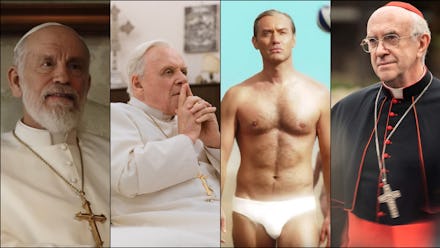Why are there so many new shows about popes?

I’m feeling a little bewildered by all the papal content coming our way these days. There’s The New Pope, which is a spinoff of The Young Pope — the HBO show starring Jude Law as a pontiff with a penchant for... Speedos? In the new series, he’s still the pope, but he’s in a coma. So now there’s another pope, played by John Malkovich, which makes two popes, but that’s not the name of this show.
The Two Popes is a new Netflix film starring Anthony Hopkins as Pope Francis and Jonathan Pryce as the future Pope Benedict. It’s about the historic, real-life meeting in 2013 between the two men — the first time in 600 years two popes met face-to-face. When you think about it, this movie probably should’ve been called The New Pope, but I guess that name was already taken. Netflix is pushing The Two Popes as one of its big Oscar contenders, alongside The Irishman and Marriage Story.
There’s actually a bit of overlap in the narratives of The New Pope and The Two Popes: both center on the dynamic between a pair of pontiffs, an abnormality that’s rife for drama. And both feature a younger, more liberal pope agitating for change in the face of centuries of tradition.
Promos for The Two Popes frame the meeting between Francis and Benedict almost as a buddy comedy. The trailer opens with an exchange about the Beatles song “Eleanor Rigby.”
“Who?” Pope Benedict asks, “I don’t know her.”
Director Fernando Meirelles said the film is “about tolerance and learning to listen to one another.” Pryce, who plays Benedict, described the movie to Variety as “two old men talking about politics and morality.”
Though they’re both elderly Catholic priests, Francis and Benedict are portrayed as being on opposite ends of the ideological spectrum, which lays the groundwork for plenty of pithy dialogue between pontiffs. But some Catholics find this depiction reductive. “To the extent it assumes that Benedict was a rigid doctrinal hardliner and hide-bound traditionalist, while Bergoglio was a freewheeling pastor and would-be revolutionary, Church-watchers will smile,” the Catholic Herald wrote.
Paolo Sorrentino’s two Pope series (The Young Pope and The New Pope) paint a dramatic, exaggerated, opulent and (some might say) blasphemous portrait of the Catholic church. On one hand, the filmmaker said he’s entranced by the grandeur of the Vatican. “It’s very close to my idea of mise-en-scène [artistic design]. The ritual, the theatrical aspect of the Catholic Church is something that I like very much,” Sorrentino told Australia’s Special Broadcasting Service (SBS).
But on the other, the show is a takedown of the more nefarious sides of the church. “The series tries to take a broad approach to the topic of religious fanaticism,” Sorrentino told Variety. “Forms of fanaticism can also be found within a Catholic context.” Over the course of the first season, Law’s character Lenny Belardo, aka Pope Pius XIII, mounts an insurrection from within, advocating to loosen the church’s restrictive doctrine.
Suffice to say, The New Pope and The Two Popes aren’t realistic depictions of the Vatican. They’re glitzy, pithy, Hollywood-ized imaginings of what being pope might be like. What our fascination with the popes reveals, however, is how mysterious and enigmatic the Catholic church has made its transfer of power and how complicated religious doctrine can become when institutions don’t adapt to the times.